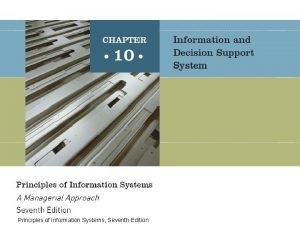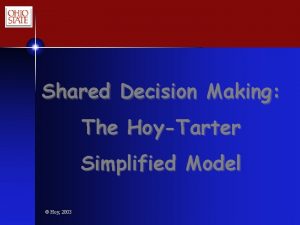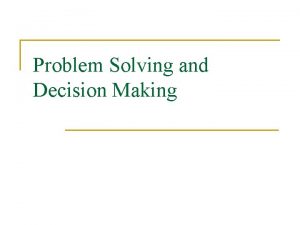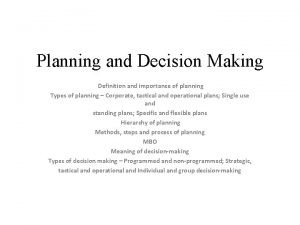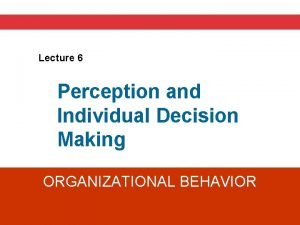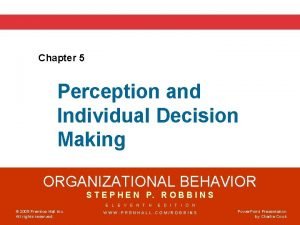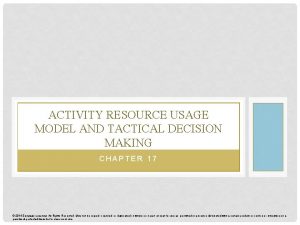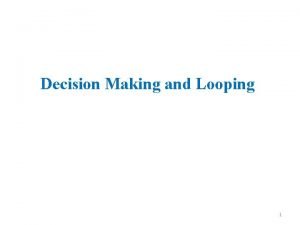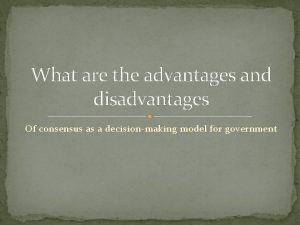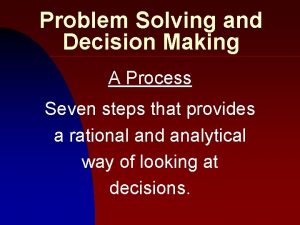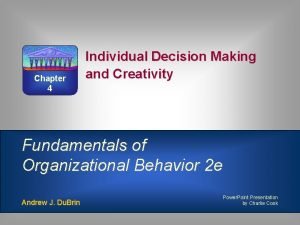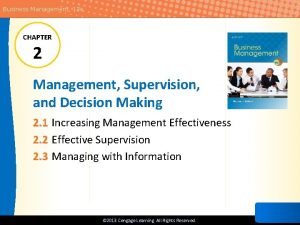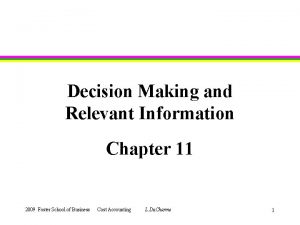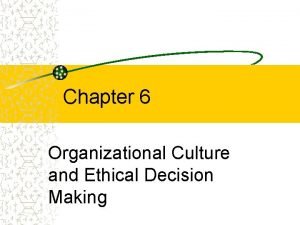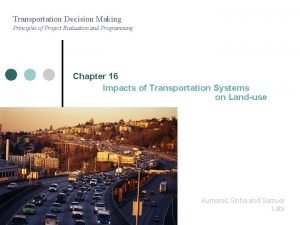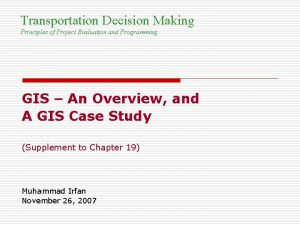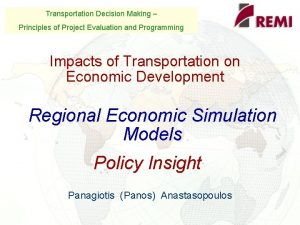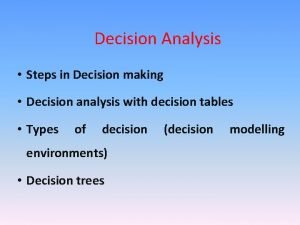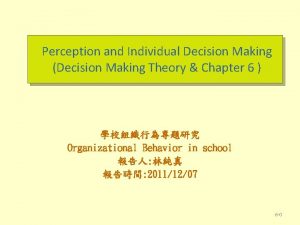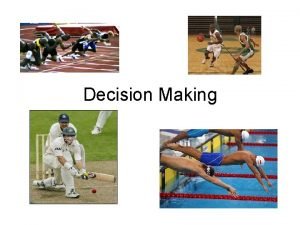Transportation Decision Making Principles of Project Evaluation and











































- Slides: 43

Transportation Decision Making Principles of Project Evaluation and Programming Chapter 17 Social and Cultural Impacts of Transportation Systems Kumares C. Sinha and Samuel Labi 1

Outline n Definitions n Impact Mechanisms n Performance Measures n Equity and Environmental Justice n Procedure for Social and Cultural Impact Assessment n Assessment Tools n Mitigation Measures n Legislation 2

Social Impacts According to FHWA (1982), social impacts are: n destruction or disruption of human-made resources, n social values, n community cohesion, n availability of public facilities or services, n displacement of people, businesses and farms; and n disruption of desirable community and regional growth. 3

Social Impacts n IOCGP (2003) defines social impacts as “the consequences to human populations of any public or private actions that alter the ways in which people live, work, play, relate to one another, organize to meet their needs and generally cope as members of society. ” n FTA (2005) describes social effects as the changes in physical layouts, demographics, and sense of neighborhood in local communities. 4

Cultural Impacts n According to National Historic Preservation Act of 1966, a project is considered to have adverse effects on cultural environment if it causes direct or indirect alteration of “any characteristics of a historic property in a manner that would diminish the integrity of the property’s location, design, setting, materials, workmanship, feeling, or association. ” 5

Legislation 1970 Federal Highway Act 1970 National Environmental Policy Act 1990’s Executives Orders 6

Developing Countries n Social Impact Assessments required by World Bank sociocultural n institutional n historical n political effects n n Emphasis on Poverty Alleviation 7

Distributive Effects n Across community groups, population groups, ethnic groups n Spatial and temporal n Should be considered when n urban ROW requirement is large n Large displacement of households, businesses, community amenities, historic districts and landmarks n conflicts with local plans n significant change in traffic characteristics n adverse effects on vulnerable segments of population 8

Impact Mechanisms n Direct n Relocation n Barriers n Integrative features n Indirect n Cumulative 9

Relocation Effects n Physical, emotional and financial stresses n Removal of formal and informal social networks n Vulnerable businesses include grocery shops, banks, and shopping centers, gas stations, hotels, motels and restaurants n Community facilities such as schools, churches, and recreation areas n Vulnerable population segments are the elderly, low-income families, long-time residents, handicapped persons, and minority and ethnic group members. Also, families with school-age children 10

Barriers n Roads and rail tracks can affect the structure, function and social pattern of surrounding neighborhoods n Physical and psychological barriers n Elderly, young, and residents who travel on foot or bicycle n Isolation of community facilities, services, and institutions Integrative Features n Pedestrian walkways, bikeways, trails and other facilities. n Beneficial sociocultural impacts. 11

Indirect Impacts n Increased traffic can lead to psychological encumbrances that reduce the extent and quality of social interaction in the community n Noise, dust, and debris, and reduced safety n Loss of parking affecting operation of businesses and community facilities n Opening of new areas, introduction of settlers and external intrusions, rural to urban migration 12

Cumulative Impacts n Combined effects of past, present and future actions n Seemingly minor projects considered together can have significant impacts n Counterbalancing effects of beneficial and adverse impacts. 13

Target Facilities n Schools n Religious institutions n Playgrounds, parks, and recreational areas n Hospitals, clinics and other medical facilities n Residential and social facilities for the elderly n Social service agencies n Libraries 14

Target Groups n All persons in the impact area n Elderly, handicapped, non-drivers and transit-dependent persons, n Minority groups n Low-income or poverty-stricken individuals n Groups vulnerable to conflict, violence, or economic shocks 15

Performance Measures n Community Cohesion – the social network and actions that provide satisfaction, security, camaraderie, and identity to members of a community or neighborhood n Stability Index – to measure levels of community cohesion – the longer the bength of time that residents lived in a community n Cultural Impact – the possibility and extent of encroachment of archeological sites, areas of historic schools, Amish and Mennonite communities, and establishments registered with the National Register of Historic places 16

Table 17. 1 Performance Measures for Social Impacts 17

Performance Measures for Cultural Impacts 18

The Issue of Poverty Alleviation in Developing Countries n Transportation plays a critical role in developing the economy and strengthening the sociocultural fabric and is also critical for day-to-day subsistence n Improved transportation systems facilitate the participation of low- income residents in social, cultural and political processes and thereby help such people to accumulate adequate physical, financial and social assets to get out of poverty n Investments that reduce the distance of time to school contribute to increased female enrollment rates n Increased access to local health care facilities reduces the time that women and girls need to spend on in-home care for sick or aging family members n Refer to A Sourcebook for Poverty Reduction Strategies (World Bank, 2002) for guidelines for using poverty reduction as a performance measure. 19

Equity and Environmental Justice n Equitable distribution of both positive and negative ecological, economic, and social impacts across racial, ethnic, and income groups n Rawl’s Theory of Justice: n All social primary goods, such as liberty, opportunity, income, and wealth, are to be distributed equally, and n If such goods are not distributed equally, they are to be distributed to favor the disadvantaged. 20

n Environmental justice principles and issues may differ from country to country n World Bank describes social sustainability as a provision of equitable economic opportunity for the diverse social groups n The attainment of environmental justice is a key equity -related performance measure n Analysis of distributive effects helps to identify and address the issue of environmental justice 21

Impacts Related to Environmental Justice* 22 *Table 17. 2

Distribution of Costs and Benefits of Transportation Projects* 23 *Figure 17. 1

n The overlap of Sets 1 and 2 are those who incur both costs and benefits n The overlap of Sets 3 and 2 refers to minority and low- income people who are made worse off by the project n The overlap of Sets 3 and 1 refers to minority and low- income people who benefit from the project n The overlap of all 3 sets represents minority or low- income people who receive some benefits and also incur some costs 24

Distribution of Project Costs and Benefits n Example of Atlanta Metro Using Income Groups n Medium-income zones were estimated to receive less net benefits than lower-and higher-income zones 25

26

figure 17. 2 27

Impact Area n Influenced by the available level of aggregation of socioeconomic data n Should generally include communities within and immediately surrounding the project area n Consultation with state local organizations 28

Potentially Affected Groups n Public hearings, interviews, and surveys n Cluster analysis using Census data on ethnic composition, income, car-and home-ownership rates, etc. to identify distinct communities n Local government and neighborhood organizations 29

Community Profiles and Inventory of Sociocultural Resources n Existing conditions and trends n Census data and MPO’s n Interviews and surveys n Cultural resources inventory n Visual maps, tables, graphs, and narrative texts. 30

Prediction of Sociocultural Impacts n Determination of expected levels of social and cultural capital after implementation and assessing these levels vis-à-vis the projected conditions n Judgements of expects through Delphi process n Response of affected public using comparable areas or interviews 31

Evaluation of Social Impacts Should include the following: n Application of screening criteria n n n if the impact is likely to occur, who will be affected, and where and how scale, severity, and extent potential for mitigation duration of the impact over time and its reversibility associated economic costs institutional barriers n Consideration of relevant standards and criteria n from professional groups and government institutions n Comparison with spatial (regional/national) and temporal averages (growth rates). 32

Example 17. 1 Metro-Rail versus BRT Expert consultations, field inspections and aerial photos. BRT provides better access to community facilities and parks; adverse impact on community cohesion is less for Metro; displacement of households and businesses is more for metro due to increased ROW needs; no impact on minority or lowincome segments. Metro will have more accessibility problem for disabled. During construction, pedestrians, transit users, and bicyclists experience increased inconvenience and safety risks. Some archeological sites will be affected by metro, and BRT has adverse effects on a historic cathedral. 33

Ratings of Various Levels of Socio Cultural Impacts* *Table E 17. 1. 1 34

Sociocultural Impacts of Rail and BRT* -5 -2 -4 -1 -3. 00 -2. 75 Table E 17. 1. 2 35

Example 17. 2 A new highway section to serve a planned BRT to link LBD to the suburbs. GIS analysis of two most affected neighborhoods. Assess the social impact in terms of community cohesion. 36

Assessment of Community Cohesion Table E 17. 2 37

Example 17. 3 Use of sociocultural impact checklist Alt 1 yields 10 adverse impacts with 5 permanent Alt 2 yields 9 adverse impacts with 4 permanent Therefore, Alt 2 is somewhat more desirable 38

Example 17. 4 Airport runway expansion will require acquisition of additional nearby land from an old, established neighborhood. Will involve significant relocation. Identify the social groups that are most likely to be affected and discuss the nature of their difficulties. 39

Solution: Using census data: a. Groups: elderly, handicapped, low-income, households with school-age children, non-English speaking ethnic and racial minority, and long-term residents b. Businesses: Small businesses that cater to local clientele, typically family-owned, ethnic or minorityowned. Specific difficulties can be identified through field surveys and interviews. 40

Tools for Sociocultural Impact Assessment: Qualitative a. Expert consultation through roundtable and brainstorming sessions, focus groups, and Delphi techniques for consensus building b. Field solicitations (neighborhood surveys, interviews and questionnaires) c. Field solicitations for organized involvement of public bodies - Citizen advisory groups, public meetings, community events, special workshops. d. Field solicitations (on-site analysis) - Walking through common routes, recreational areas, and places of social gathering, such as malls, barbershops, and so on. e. Comparative analysis 41

Quantitative Tools a. Visual tools for image or data analysis - Superimposed maps to identify social and cultural impacts - Aerial photographs and GIs tools - Overlay analysis - Use of GIs tools to analyze the impact on historic sites for 12 alternative projects for the I-69 corridor b. Statistical Analysis c. Computer modeling 42

Mitigation n Preemptive n Minimization n Mitigation n Enhancement 43
 Objectives of decision making
Objectives of decision making Investment decision financing decision dividend decision
Investment decision financing decision dividend decision Principles of decision making
Principles of decision making What is strategic assessment in software project management
What is strategic assessment in software project management Decision tree and decision table examples
Decision tree and decision table examples Mamdm
Mamdm Using recursion in models and decision making sheet 3
Using recursion in models and decision making sheet 3 Chapter 6 prices and decision making assessment answers
Chapter 6 prices and decision making assessment answers Hoy and tarter decision making model
Hoy and tarter decision making model Decision making and relevant information
Decision making and relevant information Best books on problem solving and decision making
Best books on problem solving and decision making Individual and group decision making
Individual and group decision making Importance of decision making
Importance of decision making Perception and individual decision making
Perception and individual decision making Five step decision making process
Five step decision making process Individual and group decision making
Individual and group decision making Chapter 2 economic systems and decision making
Chapter 2 economic systems and decision making Decision making and branching in c
Decision making and branching in c Basic elements of planning and decision making
Basic elements of planning and decision making Individual and group decision making
Individual and group decision making Management chapter 5 planning and decision making
Management chapter 5 planning and decision making What they see
What they see Decision making and goal setting
Decision making and goal setting Chapter 2 economic systems and decision making
Chapter 2 economic systems and decision making Individual and group decision making
Individual and group decision making Activity resource usage model and tactical decision making
Activity resource usage model and tactical decision making Activity resource usage model and tactical decision making
Activity resource usage model and tactical decision making Decision making and time management
Decision making and time management Exit controlled loop flowchart
Exit controlled loop flowchart Cross cultural negotiation and decision making
Cross cultural negotiation and decision making Chapter 11 decision making and relevant information
Chapter 11 decision making and relevant information Disadvantage of consensus
Disadvantage of consensus Making judgement in reasoning
Making judgement in reasoning 7 steps of problem solving and decision making
7 steps of problem solving and decision making Chapter 2 economic systems and decision making answer key
Chapter 2 economic systems and decision making answer key Programmed decision
Programmed decision Sports and entertainment marketing team decision making
Sports and entertainment marketing team decision making Six decision making steps
Six decision making steps Decision making and creativity organizational behavior
Decision making and creativity organizational behavior Chapter 11 decision making and relevant information
Chapter 11 decision making and relevant information Chapter 2 management supervision and decision making
Chapter 2 management supervision and decision making Decision making and relevant information
Decision making and relevant information Organizational culture and ethical decision making
Organizational culture and ethical decision making Management chapter 5 planning and decision making
Management chapter 5 planning and decision making


